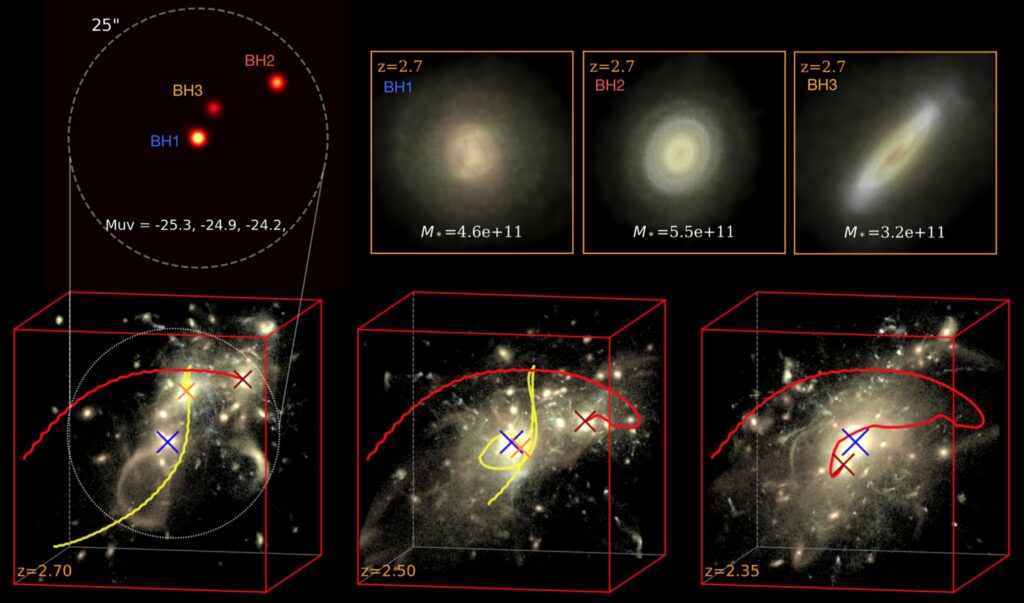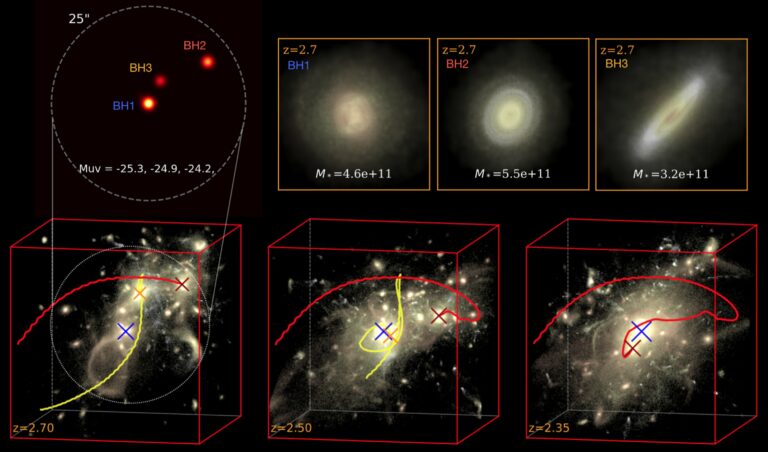One of the most massive objects in the universe has formed from a rare triplet of quasars.
Astrophysicists have uncovered the formation of ultra-massive black holes, which can weigh millions or billions of solar masses and are the largest objects in the universe, using supercomputer simulations on the Frontera supercomputer at Texas Advanced Computing Center (TACC). The study focuses on ultra-massive black holes that emerged approximately 11 billion years ago.
“We found that one possible formation channel for ultra-massive black holes is from the extreme merger of massive galaxies that are most likely to happen in the epoch of the ‘cosmic noon,'” said Yueying Ni, a postdoctoral fellow at the Harvard–Smithsonian Center for Astrophysics.
In December 2022, The Astrophysical Journal Letters published work led by Ni which discovered that ultra-massive black holes form when triple quasars merge, resulting in systems of three galactic cores illuminated by gas and dust that falls into a nested supermassive black hole. To better understand the origins of celestial bodies like black holes and stars, astrophysicists combine telescope data with computational simulations. Ni, who co-developed one of the largest cosmological simulations named Astrid, which has the highest particle or memory load in the field of galaxy formation simulations, collaborated on this project.

“The science goal of Astrid is to study galaxy formation, the coalescence of supermassive black holes, and re-ionization over the cosmic history,” she explained. Astrid models large volumes of the cosmos spanning hundreds of millions of light years, yet can zoom in to very high resolution.
Using the Frontera supercomputer at the Texas Advanced Computing Center (TACC), which is the most powerful academic supercomputer in the U.S., Ni developed Astrid, one of the largest cosmological simulations to date. Frontera’s ability to support large applications requiring thousands of compute nodes, which are physical systems of processors and memory that are combined for challenging scientific calculations, makes it an ideal platform for Ni’s Astrid simulations. According to Ni, they performed the entire Astrid simulation exclusively on Frontera, with 2,048 nodes – the maximum allowed in the large queue – being used for regular launches. This kind of simulation is only achievable on large supercomputers like Frontera.
The results of the Astrid simulations conducted by Ni reveal an astonishing discovery: the formation of black holes can theoretically reach an upper limit of 10 billion solar masses. This is a challenging task that requires large volume simulations to capture rare and extreme objects. Ni’s research group found three ultra-massive black holes that formed during the cosmic noon, a period 11 billion years ago when star formation and supermassive black holes reached their peak activity. During this epoch, the group detected a fast merger of three massive galaxies, each with a supermassive black hole at its center, which could be the progenitor of rare ultra-massive black holes after the triplets merge with each other gravitationally.
Observations of galaxies at cosmic noon using the James Webb Space Telescope will aid in revealing the coalescence of supermassive black holes and the formation of ultra-massive ones. Additionally, the future space-based NASA Laser Interferometer Space Antenna will provide better insight into how these massive black holes merge, their hierarchical structure, formation, and the history of galaxy mergers. The research group is planning a systematic study on AGN hosting galaxies to determine the morphology of AGN host galaxies and how they differ from the broader population of galaxies during cosmic noon. Supercomputers and simulation technology allow the group to model a patch of the universe in great detail and make predictions from observations, which is an exciting time for astrophysicists.
Do not forget to share your opinion with us to provide you with the best posts !




0 Comments